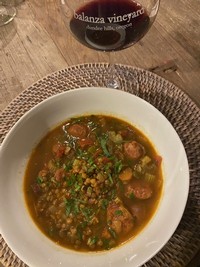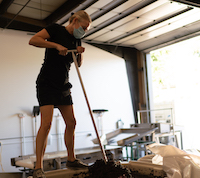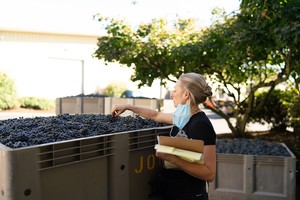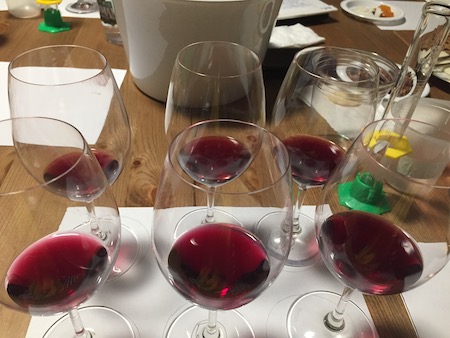What wine goes with steak?
The classic wine pairing for a big juicy steak is Cabernet Sauvignon. But why?
Well... if we look at it the ZiNG way, we'll think about what is the dominant element in the food. The eight food elements are: salt, oxalates, acidity, umami, fat, sugar, spice and protein. Clearly a steak doesn't have acidity or sugar, and it doesn't have oxalates (you'll just have to trust me on that, or come to the workshop...). I guess it could have salt or spice depending on how you season it but you'd have to really go over the top with the sauce to overwhelm the dominant element which is... protein.
So what about the Cabernet Sauvignon works well with protein? The elements of wine are acidity, viscosity, fruitiness, sugar, alcohol and tannin. While a Cabernet Sauvignon may have acidity and most likely a good amount of alcohol, it also has a lot of tannin. Those tannins bind with the protein in the steak and those mouth puckering tannins just disappear so you can taste the fruit and other elements in the wine. The wine and the food enhance each other.
During the ZiNG! workshop next month we will taste Cabernet Sauvignon with all eight of the food elements and see how each of the interactions work. Do they zing! like the protein, or are they a train wreck, making the wine taste awful and leaving us reaching for the bread to take the experience out of our mouths?
The ZiNG workshop is $40 in person at the winery or $100+shipping if you join us online. Last order for the online participation will be next week so we have time to ship you the four bottles of wine and worksheet you'll need. So.. book early! There's enough wine in the package for you to invite your friends to join you too!
Click here to get tickets.
And you can read more about ZiNG and it's creator, and our workshop host, Trish Rogers here.
Lentil and Sausage Soup recipe from Balanza Vineyard
 Chaly and I love lentils. We have enjoyed this recipe with the simplest and most accessible Oregon Pinots and also some of the most coveted Oregon Pinots. While we are Dundee Hills people, the earthiness of lentils lends itself really well to some of the wines from our Yamhill Carlton or Ribbon Ridge natives. During quarantine, we could not find lentils at the store for 2-3 weeks and I got so nervous that I found a Washington state grower that sold online via amazon and bought a bulk amount of Lentils. We just finished them off a week ago.
Chaly and I love lentils. We have enjoyed this recipe with the simplest and most accessible Oregon Pinots and also some of the most coveted Oregon Pinots. While we are Dundee Hills people, the earthiness of lentils lends itself really well to some of the wines from our Yamhill Carlton or Ribbon Ridge natives. During quarantine, we could not find lentils at the store for 2-3 weeks and I got so nervous that I found a Washington state grower that sold online via amazon and bought a bulk amount of Lentils. We just finished them off a week ago.
Balanza Family Lentil Soup
Ingredients:
2 cups Lentils
5 cups chicken stock (we like better than bouillon low salt with water)
Linguica Sausage (11 oz package)
1 green pepper
2 medium carrots
1 medium yellow onion
2 stalks of celery
2 roma tomatoes
2 large cloves of garlic
2 tsp cumin
1 tsp smoked paprika (we use Bolivian Ahi but when we don’t have it smoked paprika is nice)
1 tsp cayenne pepper
3/4 tsp tunmeric
1/2 tsp ground coriander
2 bay leaves
parsley
pinch of nutmeg
olive oil
salt and pepper to taste
Dice all vegetables (including the tomatoes)
Slice the sausage links
In a large stock pot, sauté the green pepper, carrots, onion, celery, garlic in a little bit of olive oil until the onions are soft but not brown.
Add diced tomatoes, broth, spices, and lentils.
Bring everything to a nice simmer
Add the sliced sausage and simmer for 45 minutes to 1 hour
Salt and pepper to taste
Stir in some chopped parsley (1/4 cup)
Garnish with parsley
Serve with crusty bread
Note: if you prefer lentils as a side dish rather than a soup, don’t add as much broth.
What is native fermentation?

What is native fermentation?
Native fermentation is using the indigenous yeasts from the vineyard to cause primary fermentation i.e. the process where the sugar in the grapes turns to alcohol.
When I’m working with grapes that I know are going to go to the Jezebel pinot noir, I usually inoculate them with yeast. There are a few that I tend to use more often and they’re mostly designed to highlight the fresh fruit flavors of the wine and contribute to a fleshy mouthfeel. The fermentations with these yeasts tend to be fairly uniform each year, and shorter than the wild yeasts I use for the Willful pinot noir. The yeasts are one of the tools that help me to maintain consistency each vintage.
I approach the “willful” pinot noir grapes a little differently. I do a “cold soak” for at least a week, where I keep the grapes in a chiller (usually around 48F). This allows the grape juice to be in contact with the skins for longer and builds structure in the wine, especially the more elegant type of tannins that I prefer. Then I let the fermenters warm up and whatever yeasts came in from the vineyard with them go to work and turn the sugar in to alcohol and the juice into wine. The native ‘wild’ yeasts generally ferment at lower temperatures and take longer to convert all of the sugar in to alcohol and this gives me yet more skin time to build structure in the wine, and also tends make the wines a little more aromatic. Naturally fermented wines tend to have a particularly supple, velvety texture.
I often refer to my wines as children. You have an idea of what you're going to get, but they also often surprise you, and that's one of the things I love about winemaking in general, and about native yeasts. I find they do require a little more work in the winery but I think the variety of terroir and nuance that can be expressed and the impact on the texture is well worth it to me.
What is a grape clone?
 The best way I've found to explain grape clones is comparing grapes to roses. A rose is a rose, but there are different types of roses, and each has their own unique characteristics in how they look and smell. Similarly, the different clones of pinot noir are all pinot noir, but each have their own attributes. Some are more floral and some more spicy. Some are earlier ripening and tend to be more fruit forward, and others are later ripening and are more expressive of some of the secondary flavors in grapes. And.. because it's pinot noir in Oregon, each clone will express itself in a different way depending on the site where it's grown. So.. there's a lot of choices to be made before we even start to get in to what we decide to do in the winery!
The best way I've found to explain grape clones is comparing grapes to roses. A rose is a rose, but there are different types of roses, and each has their own unique characteristics in how they look and smell. Similarly, the different clones of pinot noir are all pinot noir, but each have their own attributes. Some are more floral and some more spicy. Some are earlier ripening and tend to be more fruit forward, and others are later ripening and are more expressive of some of the secondary flavors in grapes. And.. because it's pinot noir in Oregon, each clone will express itself in a different way depending on the site where it's grown. So.. there's a lot of choices to be made before we even start to get in to what we decide to do in the winery!
In 2019 I chose not to blend a Winemaker Cuvee pinot noir, and to focus instead on a three different clones of pinot noir from three very different vineyards and I bottled three "reserve" pinot noirs from 2019, all very much with their own personality:
2019 Dundee Hills Pinot Noir: This is 100% Pommard clone pinot noir from the Balanza Vineyard in the Dundee Hills AVA. Pommard was one of the earliest clones to be planted in Oregon. It tends to be later ripening and maintains acidity pretty well. It has a soft, supple mouthfeel and when grown in the jory soils of the Dundee Hills it shows the typical bright red berry flavors of the AVA with a floral (rose?) aroma and a bright minerality. This wine is pretty and elegant and very feminine. We released this last November to the wine club and it's now available generally on our web site. $35 (47 cases produced)
2019 Ribbon Ridge Pinot Noir: This is 100% Wadensil clone pinot noir from Stewart Vineyard in the Ribbon Ridge AVA. This is the other clone that was planted in the early days of the Oregon wine industry. It tends to be very aromatic with a particularly spicy note. I think it works wonderfully with the darker red fruit flavors and slightly richer tannins of this Ribbon Ridge vineyard. We just released this to the wine club. It will be generally available on the web site in April 2021. $35 (98 cases produced)
2019 "943" clone Pinot Noir: This was my first time working with this newer pinot noir clone. I tried to research it online prior to working with it and found such varying responses to it. It seems to be particularly expressive of the terroir where it's planted. I found it in Jubilee Vineyard in the Eola-Amity Hills. I fermented it as 50% whole clusters which seems to add to what I think is the inherent peppery characteristic. Early on, it tasted almost like a Zweigelt. It's lower in alcohol (just 12.5%), with flinty, mineral characteristics and dark fruits. This is also a new release to the wine club and will be generally available on the web site in April 2021. $35 (47 cases produced).
I love working with (and drinking!) pinot noir because it can be such an expressive grape. At its best it has so many different layers of flavors. I like it when it's not overly showy. I'm not sure who described it this way (maybe Aron?) but I like it: "wines that reveal themselves over time". It doesn't smack you in the face with a big dollop of jammy fruit, or whack you over the head with a 2*4 of oak. It gently allows you to enjoy the floral perfumes, the hint of sandalwood and the suggestion of the freshly dug earth. I love wine that I find myself thinking about the day after I drank them and I find that more with pinot noir than most other varietals. Whatever your reason for drinking pinot noir, I hope you enjoy these. Regardless of clone, terroir or whatever, the only really important thing is - do you like it?
If you're interested in finding out more about pinot noir clones and about how we make decisions in the winery, please join us for our blending workshop on May 15th. We're offering it live at the winery, or online. If you plan to join us online, please sign up by May 1st so we can get the wine to you in time.

Recent Posts
-
November 16, 2024
-
May 11, 2024
-
August 8, 2023
-
December 10, 2022
-
August 6, 2022
-
March 31, 2022
-
January 17, 2022
-
December 1, 2021
-
June 2, 2021
-
March 31, 2021